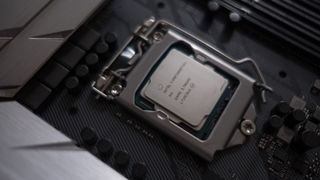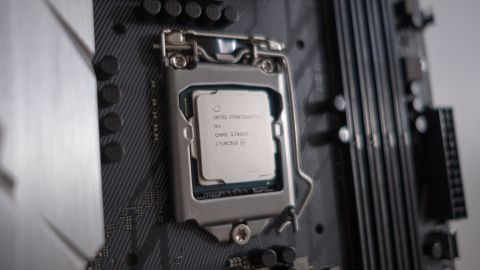TechRadar Verdict
The six-core Intel Core i7-8700K processor proves the company can do more with fewer cores than AMD Ryzen – bonus: this chip overclocks like a champ.
Pros
- +
Hyper-threading overtakes Ryzen
- +
Low-impact overclocking
Cons
- -
Overclocking only on K models
- -
Requires new motherboard
Why you can trust TechRadar
With Coffee Lake processors like the Intel Core i7-8700K, Intel had to up the core count on its mainstream processors. This was absolutely necessary, and franky, it’s hard to imagine what would have happened if Team Blue didn’t put out something like the Intel Core i7-8700K in light of how AMD has redrawn the battle lines with Ryzen and Threadripper.
Leaks show Intel Coffee Lake Refresh CPUs have T-Series models incoming
Intel’s processor shortage is dragging down PC sales
And, so, here we are.
The Intel Core i7-8700K is easily the best processor in the Coffee Lake lineup, with 6-cores, 12-threads and higher core clocks than any of the AMD Ryzen chips. After using this processor for a week, Team Blue’s 2017 flagship is everything we could ask for, even more than a year later: with otherworldly gaming performance and hyperthreading numbers that put the first generation Ryzen chips in their place. It even overclocks like a champ.

Cores: 6
Threads: 12
Base clock: 3.7Hz
Boost clock: 4.7GHz
L3 cache: 12MB
TDP: 95W
Pricing and availability
Priced at $359 (about £270, AU$460), the Intel Core i7-8700K takes on AMD’s best Ryzen 7 processors including the $399 (£319, AU$499) 1700X and $499 (£399, AU$649) 1800X.
Even if this CPU has two fewer cores than its Red-colored rivals, the 8700K pulls ahead with higher base and boost clocks of 3.7 and 4.7GHz, respectively.
A hexa-core mainstream processor is a big step forward for Intel, who previously placed anything with more than four-cores within its high-end-desktop (HEDT) E- and X-series ranges.
Speaking of, the hexa-core Skylake-X Intel Core i7-7800X may come close in price at $379 (£349, AU$495), but those X299 motherboards will cost a bit more than the new Z370 chipset. And, if you’re thinking about moving up to Coffee Lake Refresh, you’ll certainly have to pony up for a new motherboard, as older Z270 platforms, don’t support the 9th-generation’s higher power delivery demands.
While we’re adding up all the extra costs, bumping up the core count has resulted in a small price premium. Its predecessor, the Kaby Lake Intel Core i7-7700K, was a bit more affordable at $349 (£299, AU$459).

GPU: Nvidia GTX 1080 Ti (11GB GDDR5X VRAM)
RAM: 32GB Vengeance LED DDR4 (3,200MHz)
Motherboard: Asus ROG Strix Z370-E Gaming
Power Supply: Corsiar RM850x
Storage: 512GB Samsung 960 Pro M.2 SSD (NVMe PCIe 3.0 x4)
Cooling: Thermaltake Floe Riing 360 TT Premium Edition
Case: Corsair Crystal Series 570X RGB
Operating system: Windows 10
Performance
The Core i7-8700K brings Intel’s multi-core performance up to and well above the high benchmark Ryzen has set this year.
This chip soundly overtook AMD’s competing Ryzen 7 1700X in Geekbench 4, with a score several thousands of points higher – by extension, this makes the previous-generation Intel Core i7-7700K’s multi-core numbers look like a joke.
What’s even more impressive is Intel’s latest part beat the pants off its predecessor in all our single-core tests, too.
All of this processing power also ends up helping the 8700K convert video as fast as some of the industry’s most overpowered CPUs, like the Intel Core i9-7980XE and AMD Ryzen Threadripper 1950X – though these aforementioned chips will still win any hyper-threading race through sheer brute force.
When it comes to gaming, in our testing, there’s not going to be a huge improvement over last generation. Compared to last year’s Core i7-7700K, the shiny new hexa-core CPU increased frame rates across the board, with the greatest improvements seen in titles running at Full HD and Ultra quality settings.









Features and chipset
Intel worked some black magic to squeeze 18 cores into the tiny Intel Core i9-7980 XE, and some of that witchcraft has found its way into the Intel Core i7-8700K. Rather than packing in two more cores than we ever saw on Kaby Lake, the processor package hasn’t grown by a single millimeter.
While that’s impressive, it’s also slightly annoying that this new generation of CPUs still demands us to buy into a whole new motherboard.
However, the Z370 isn’t actually much of an improvement over last-gen’s Z270 chipset. It still only supports dual-channel memory and, out of the 40 available PCIe lanes, only 16 are directly connected to the processor. The other 24 PCIe lanes share a single DMI 3.0 connection to the processor – which means you can only squeeze out the full potential of two GPUs – or one graphics card and two M.2 NVMe SSDs.
Thankfully, Z370 does have a silver lining of adding official support for DDR4 2,666MHz memory – up from the 2,400MHz frequency seen on Z270 – and improved power delivery for some of the greatest overclocking we’ve seen on a mainstream processor.

Overclocking and heat
Obviously, with a core count increase comes the inevitable rise in power consumption. However, we weren’t expecting the Intel Core i7-8700K to be twice as power hungry as its Kaby Lake predecessors. Still, at idle, the 6-core chip sips electricity at an average of five wats, way less than the 12 watts the AMD Ryzen 1700X gulps, so Intel hasn’t completely abandoned energy efficiency.
On the flipside, the 8700K is more than happy to soak up extra current and push itself beyond its rated maximum 4.7GHz frequency.
We easily achieved a 5.0GHz frequency across all the cores just by giving the processor an extra 0.02 volts of juice, and only saw the maximum temperature jump to 85-degrees Celsius and 152.84 watts of power consumption. Another extra dab of juice allowed us to further clock up the Intel Core i7-8700K to 5.1GHz across all cores without significantly detrimental effects.
Pushing the six-cores to 5.2GHz unfortunately proved to be too unstable to even get Windows 10 to load properly. While this might seem disappointingly short from the 8700K’s maximum speed of 4.7GHz, we’re impressed with how little extra heat and power demands overclocking created.
At the end of the day, the Intel Core i7-8700K stays relatively cool, maxing out at just 76 degrees, while operating normally and comfortably under a Thermaltake triple radiator as its cooling blanket. The only time it got a bit hot under the covers was when we overclocked the processor to that 5.1GHz mark, where it reached a peak temperature of 87 degrees.

Final verdict
Intel Core i7-8700K proves Team Blue is still the top dog in the processor world. Coffee Lake is a clear improvement over Kaby Lake with impressively higher single-core and multi-core numbers, and ever-so-slightly better gaming performance. What’s more, the staggering hyper-threading performance puts it well above AMD’s octo-core Ryzen processors and even into the realm of some high-end desktop (HEDT) parts.
The Intel 8700K gets a little hotter and more power hungry than we would like, but that was somewhat expected with the bump up in cores. What we didn’t expect as a pleasant surprise was the ease of overclocking the processor to 5.1GHz, not to mention the relatively low-impact of doing so.
The toughest pill to swallow out of all of this is having to get a new motherboard to even use Coffee Lake-S. But, if you’re willing to spend the money to upgrade both components, the Intel Core i7-8700K is the best mainstream processor on the market, and it comes with all the bragging rights of having the highest benchmark numbers in its class.
Kevin Lee was a former computing reporter at TechRadar. Kevin is now the SEO Updates Editor at IGN based in New York. He handles all of the best of tech buying guides while also dipping his hand in the entertainment and games evergreen content. Kevin has over eight years of experience in the tech and games publications with previous bylines at Polygon, PC World, and more. Outside of work, Kevin is major movie buff of cult and bad films. He also regularly plays flight & space sim and racing games. IRL he's a fan of archery, axe throwing, and board games.

Microsoft is building wooden data centers in its latest push to cut emissions - could this be the future of AI power?

Kill two birds with one stone — recycled polystyrene material that looks like bird feather could be used to generate electricity from waste energy in air

Nvidia’s DLSS is an obvious choice over AMD’s FSR, but this shouldn’t dictate your GPU buying decisions
Most Popular


